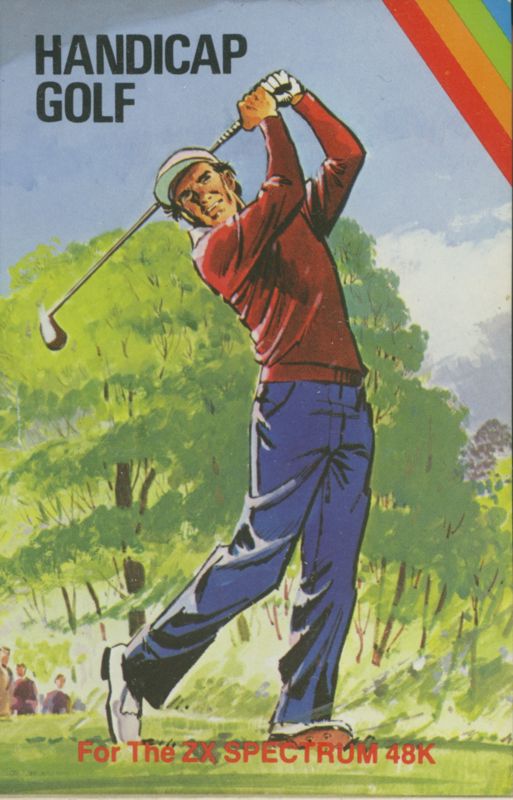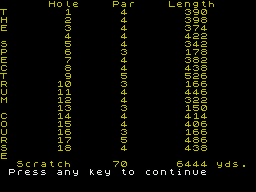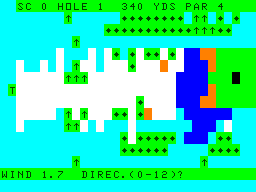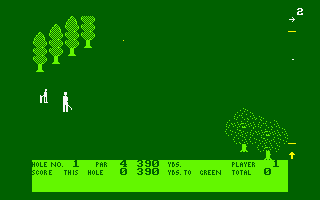Retro Replay Review
Gameplay
Handicap Golf delivers a refreshingly straightforward approach to simulating the joys—and frustrations—of the fairway. From an overhead perspective, you guide each shot by entering two critical values: the clock-face angle for direction and a power rating between 0 and 250. This system strips the experience down to pure decision-making, challenging you to visualize your trajectory and account for factors like wind before you execute the perfect swing.
(HEY YOU!! We hope you enjoy! We try not to run ads. So basically, this is a very expensive hobby running this site. Please consider joining us for updates, forums, and more. Network w/ us to make some cash or friends while retro gaming, and you can win some free retro games for posting. Okay, carry on 👍)
The wind indicator appears alongside your input prompt, forcing you to weigh the breeze before dialing in your angle and force. It’s a deceptively simple mechanic that adds a layer of strategy to what might otherwise be a rote exercise in trial and error. Each hole is self-contained on a single screen, with strategically placed woods, bunkers and water hazards keeping you on your toes—misjudge your shot and you’ll pay the price by retracing your steps or landing in a tricky bunker trap.
Progressing through Handicap Golf feels methodical. There’s no hand-holding or on-screen indicators of your ball’s flight path; instead, you rely on your understanding of the clock dial and the power scale. Those who appreciate learning curves will find this rewarding, while newcomers might need a few practice holes to build confidence. The lack of menus or sub-screens means you’re always in the game, making each shot an opportunity to refine your skills.
Graphics
As a title written entirely in BASIC, Handicap Golf’s graphics are rendered with slowly drawn text characters. Trees become clusters of “X” symbols, bunkers are outlined with hyphens and periods, and the green might be nothing more than a bordered space on the screen. There’s no resorting to bitmaps or sprites—everything you see is formed by the same characters you’d type at the prompt.
This minimalist aesthetic has its own retro charm, evoking the earliest days of home computing. Watching the course map crisscross the screen line by line adds a sense of anticipation—and occasionally impatience—to the pre-shot ritual. While modern players might balk at the lack of smooth animations, retro enthusiasts will appreciate the authenticity of the slowly constructed visuals.
Color usage, if available on your BASIC interpreter, is typically limited to a few hues for contrast, but most installations stick to monochrome. The sparse presentation leaves plenty to your imagination: that lone “O” is your ball, the dashes and pipes form the fairway, and you’re free to mentally fill in the lush grass or shimmering water. In this sense, Handicap Golf feels like a throwback text adventure—only with a little white ball instead of a sword or lantern.
Story
Handicap Golf doesn’t come with a narrative campaign or a cast of characters; the story is entirely your journey from the first tee to the final hole. There’s no tournament bracket to conquer or leaderboard rival to outplay—only the scorecard and your personal best. This bare-bones approach focuses squarely on the sport itself, inviting you to craft your own progression and set your own goals.
Each hole offers a new layout of trees, bunkers and water hazards, so the tension comes from mastering individual challenges rather than following a scripted plot. You might imagine winding fairways through a misty mountain course or a seaside links exposed to gusty winds. In the absence of cutscenes or dialogue, the mental picture you build becomes the game’s unofficial backstory.
For players who demand a rich narrative, Handicap Golf may feel under-dressed. But in its minimalism lies an opportunity: to overlay your own story on the course as you see fit. Perhaps you’re teeing off at a storied championship, aiming to break a long-standing club record, or simply enjoying an afternoon round with a makeshift caddy perched by the keyboard. It’s a canvas for your imagination.
Overall Experience
Handicap Golf is a product of its era: unpretentious, text-based and delightfully focused on core mechanics. There’s no hand-holding, no visual fanfare—just the rhythm of entering your shot parameters, surveying the wind, and watching characters fill the screen. For retro purists and programming hobbyists, this simplicity is its greatest strength, offering raw, unfiltered gameplay that feels like an exercise in both skill and patience.
Modern gamers accustomed to flashy graphics and dynamic physics engines may find the presentation austere, and the learning curve steep. Yet, those willing to embrace its stripped-down charm will discover a surprising depth beneath the chunky ASCII facades. Each hole becomes a mini puzzle, each breeze a variable to conquer, and each round a chance to shave strokes off your personal handicap.
In a market crowded with golf sims that boast photo-realistic courses and motion-captured swings, Handicap Golf stands apart as a time capsule. It’s not for everyone, but for collectors, BASIC enthusiasts and players seeking a nostalgic challenge, it offers a unique slice of gaming history. If you value strategy over spectacle and enjoy the satisfaction of mastering an old-school system, Handicap Golf deserves a spot on your digital shelf.
 Retro Replay Retro Replay gaming reviews, news, emulation, geek stuff and more!
Retro Replay Retro Replay gaming reviews, news, emulation, geek stuff and more!









Reviews
There are no reviews yet.